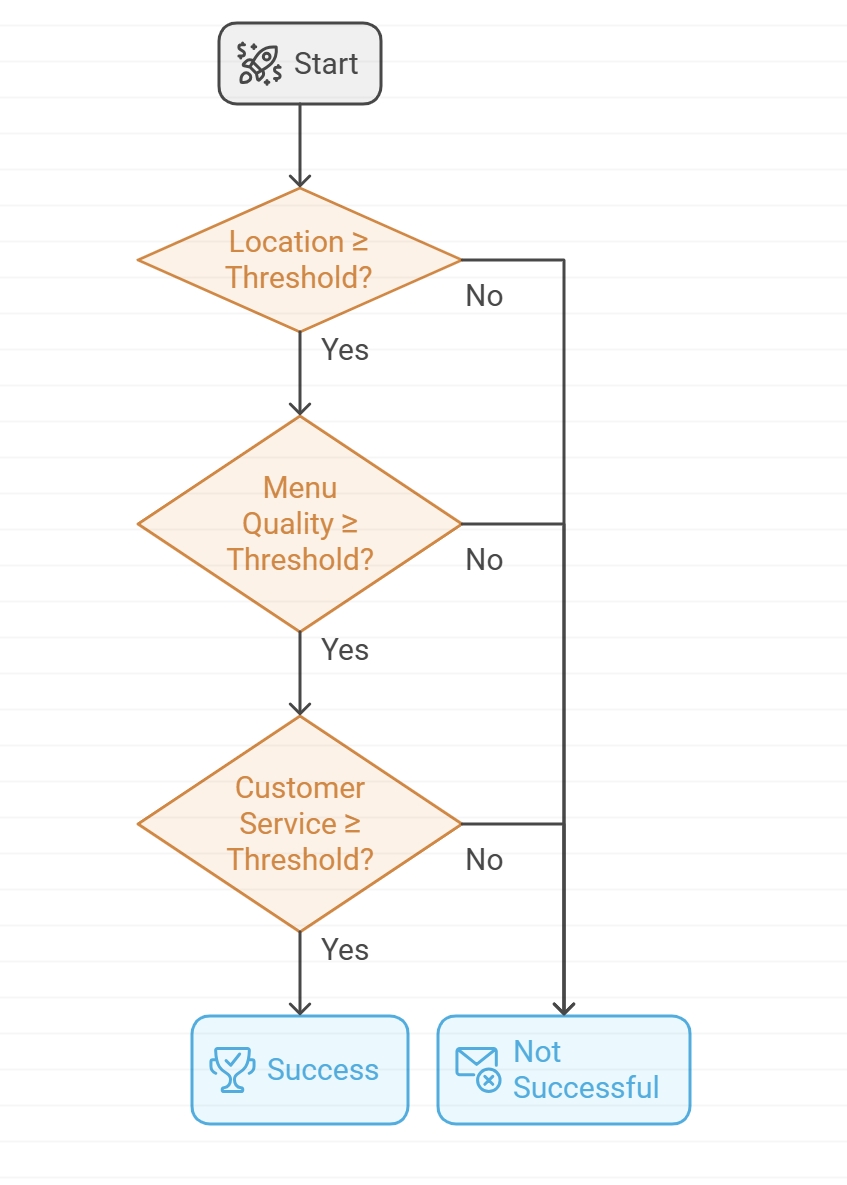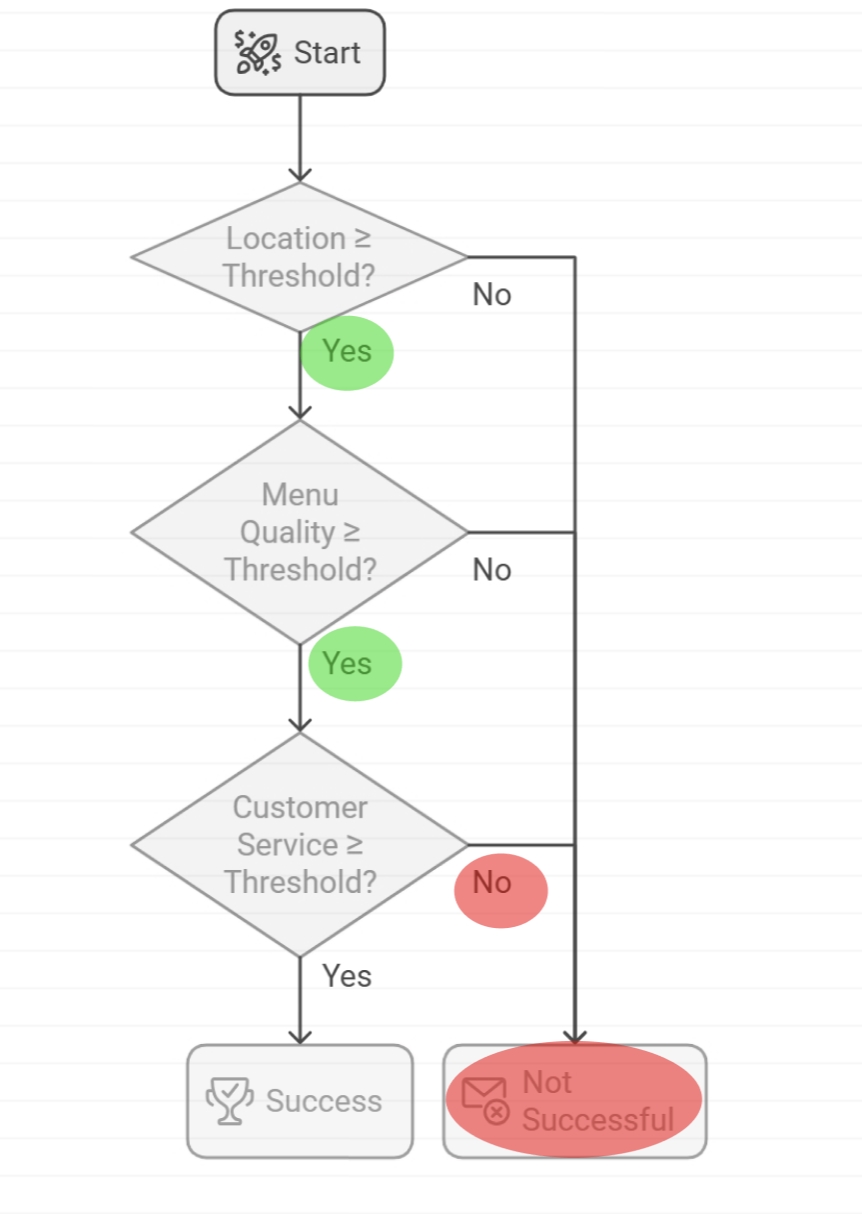The Mathematics of Failure

GET THE #1 EMAIL FOR EXECUTIVES
Subscribe to get the weekly email newsletter loved by 1000+ executives. It's FREE!

I've been reading an interesting book, it's called The Right It"

I don't know if it's just the way that my brain works but it had a very clever mathematical formula that explained failure in a way that I had never thought of before.
The Success Equation
Imagine success as a mathematical equation:
Success = (Factor₁ ≥ Threshold) × (Factor₂ ≥ Threshold) × (Factor₃ ≥ Threshold)
For success to occur, each factor must meet or exceed its critical threshold. If any single factor falls below its threshold, the entire equation fails. This creates a binary outcome — you either succeed (1) or fail (0).
Example of Opening a Restaurant
Successful Example
A small family-owned Italian restaurant focuses on three key factors:

- Location (Factor₁): Situated in a busy downtown area with lots of foot traffic (≥ Threshold).
- Menu Quality (Factor₂): Authentic, delicious Italian food made with fresh ingredients (≥ Threshold).
- Customer Service (Factor₃): Friendly, attentive staff who create a welcoming atmosphere (≥ Threshold).

Since all three factors meet or exceed their thresholds, the restaurant thrives. Word-of-mouth spreads, repeat customers return, and the restaurant becomes a local favourite.
Unsuccessful Example (One Factor Fails)
Another restaurant focuses on similar factors but falls short in one area:

- Location (Factor₁): Situated in a busy downtown area with lots of foot traffic (≥ Threshold).
- Menu Quality (Factor₂): Authentic, delicious Italian food made with fresh ingredients (≥ Threshold).
- Customer Service (Factor₃): Staff are inattentive and slow to respond, leading to frustrated customers (< Threshold).
I think the above is very true of a lot of restaurants that I went to in Paris!
Even though the restaurant has a great location and excellent food, poor service undermines the overall experience.
Customers leave negative reviews, and many do not return, causing the restaurant to struggle.


You can do so many things right and still fail if one critical factor falls short.
The Mathematics of Failure
Here’s where it gets interesting. The more factors you have, the chances of failure increase exponentially.
For a system with n factors, there are 2ⁿ − 1 ways to fail, but only one way to succeed. Let’s break this down:
- With 3 factors:
- 7 ways to fail (2³ − 1)
- 1 way to succeed
- With 5 factors:
- 31 ways to fail (2⁵ − 1)
- 1 way to succeed
- With 10 factors:
- 1,023 ways to fail (2¹⁰ − 1)
- 1 way to succeed
The real world is complicated! It would be easy to think of a lot of cases where there is more than 10 factors that you need to get right.
No wonder so many things fail!
Real-World Applications
Netflix’s Early Success
Drawing from the Netflix example, when they decided to focus on DVD rentals, they effectively reduced their success factors to:
- Customer acquisition
- DVD inventory management
- Distribution efficiency
By eliminating factors like retail presence, competitive pricing against Amazon, and maintaining a dual business model, they significantly increased their chances of success.
Startup Launch Strategy
Consider launching a new product:
Complex Approach (Many Factors):
- Perfect product
- Ideal market timing
- Optimal pricing
- Full feature set
- Complete marketing strategy
- Perfect customer service
- Scalable infrastructure
- Competitive positioning
- Brand recognition
- Sales team effectiveness
The reason that this approach really resonates with me is that when I first started making software I thought it was all about getting more features into a product.
When you list out all of the things that are required to succeed, it becomes clear that there is far more to the equation than just the product.
Simplified Approach (Few Factors):
Y Combinator principles come into play here. When you start something, keep it simple:
- Working prototype
- Clear target customer
- Basic distribution channel
The Power of Constraint
This mathematical reality leads us to several powerful insights:
1. Start with Minimal Viable Factors
Instead of trying to perfect everything at once, identify the absolute minimum number of factors that must work for initial success. This is why the MVP (Minimal Viable Product) approach works so well when you are starting something new.

The Apple Vision Pro is a staggering example of this formula:
- $130 billion to make!!
- Started in 2015
- 20,000 patents Filed
And yet, by Apple's standards, it was a complete failure. In the second quarter of 2024, Sales has dropped by 80%.

The above chart was their sales projections for the Vision Pro before it released. Dropping by 80% 6 months after you have launched is a failure, especially considering the massive investment.
Remember they would have been reading a lot of Steve Jobs quotes too and yet for a number of reasons it hasn't worked out.
2. Sequential vs. Simultaneous
Rather than trying to optimise all factors simultaneously, focus on getting one factor right before adding complexity. This explains why successful companies often start with a single product or service before diversifying.
3. The Focus Premium
When you reduce the number of factors, you can invest more resources into each one, increasing the likelihood of reaching the critical threshold for that factor.
A really easy way of doing this is the North Star Metric.
Practical Implementation
Audit Your Current Approach
- List all factors currently considered critical
The above is really important as the strange thing about this is that you might not even know all of the factors that contribute to your success!
- Question whether each factor is truly necessary for initial success
- Identify which factors can be deferred to later stages
Simplify Your Success Criteria
- Reduce your success factors to the minimum viable number
- Ensure each remaining factor is truly essential
- Define clear thresholds for each factor
Create a Staged Approach
- Start with the minimum number of factors
- Add complexity only after achieving initial success
- Monitor how each new factor affects overall performance
Common Pitfalls to Avoid
Complexity Creep
- Resist the urge to add "nice-to-have" factors
- Question every new variable introduced to the system
- Regularly audit existing factors for necessity
Threshold Confusion
- Don’t mistake perfection for the threshold
- Set realistic, achievable thresholds
- Adjust thresholds based on real-world feedback
Conclusion
The mathematics of success teaches us that simplicity isn’t just an aesthetic choice—it’s a strategic advantage. By consciously limiting the number of factors required for success, we dramatically increase our odds of achieving it.
When faced with a complex challenge, ask yourself: "What are the minimum number of factors that must work for this to succeed?" Then focus relentlessly on those factors until they exceed their thresholds.
Remember, it’s not about having no complexity — it’s about adding complexity at the right time, after you’ve secured success with your core factors.

















